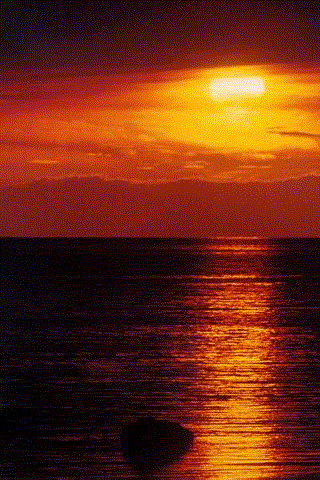Hagi City in Yamaguchi Prefecture where the
samurais (warriors) of Mohri Clan triggered Meiji
Restoration 140 years ago, heavily leaves the
feudal scene of the castle town. Meiji Restoration
was a huge historical event which made Japan
move to the track towards a modernized nation.
The samurais of lower class acted as the motive
power of the revolution. Many of them left Mohri
Clan and carried out the revolution at the risk of
their lives.
You might imagine they appear here and there
along the streets or the lanes coming out of the
white walls or the wooden fences. You will see
many pine trees having beautifully shaped
branches and many summer orange trees with
heavy fruits.
There are kindness by the local dwellers for
travelers, and you will be able to take delicious
sea food feasts in Hagi City. You can see the
clean sky and the sea of north side of the country.
TERUMOTO MOHRI WHO WAS HEADING THE CLAN BUILT HAGI CASTLE TOWN FROM SCRATCH
400 YEARS AGO
Terumoto Mohri who was a grandson of Motonari,
the founder of the clan was defeated by Iyeyasu
Tokugawa, the founder of Edo Shogunate, in
Sekigahara Battle between Toyotomi's Force and
Tokugawa's Force, which formed the watershed
of obtaining absolute dominant power of Japan.
Terumoto acted in this battle as the supreme
commander of Toyotomi's Force.
He was significantly cut his own domain by
Iyeyasu, which his anscesters had conquared
and had been spreading to eight countries by only
two ones, namely Hohfu and Nagato by Iyeyasu.
Since then, Mohri Clan was also called Choshu
Clan or Hagi Clan.
Consequently, Terumoto had to move the castle
in which he lived, to Hagi. As a result, his fief
decreased to 360 thousand Kokus from 1,500
thousand Kokus (one Koku corresponds to 100
straw rice bags. In feudal age in Japan, landlords'
richness was measured by how many kokus of
rice their domain could produce).
Hagi is the castle town which Terumoto built
from scratch for four years by giving his whole
mind on delta Abugawa River flowing out to the
Japan Sea. The city cerebrates 'The 400th
Anniversary in 2004. As Hagi City Government
has taken effort to conserve the whole castle
town, so many historical monuments are well
preserved as same as buildings at the end of
Edo Era. Surrounded by Abugawa River,
Hashimotogawa River and Matsumotogawa River
in east, west and south sides, many samurais'
houses spreaded along streets and lains of
checkerboard fully on the delta. In the area
samurais of higher class lived, where long and
white walls stretched.
Hagi Castle with a castle tower ('tenshukaku' in
Japanese) in which successive heads of Mohri
Clan had lived, stood up on the edge of island
-like area seperated by a canal between the inlet
with Hagi Harbor and the mouth of Matsumotogawa
River. The back side of Hagi Castle is Mt.Shigetsu
of 145 meters high (See Map of Hagi City). It is
regreted that Hagi Castle was destructed samely
as the other many castles throughout the country
by the policy of Meiji Government which promoted
to prevent from rebellions by former clans, and Hagi
Castle leaves only huge stones wall today. It is said
that the destroyment of Hagi Castle was done by
Takamitsu Kido's initiative, who was called as "Three
Great Persons in Meiji Era" together with Takamori
Saigoh and Toshimitsu Ohkubo.
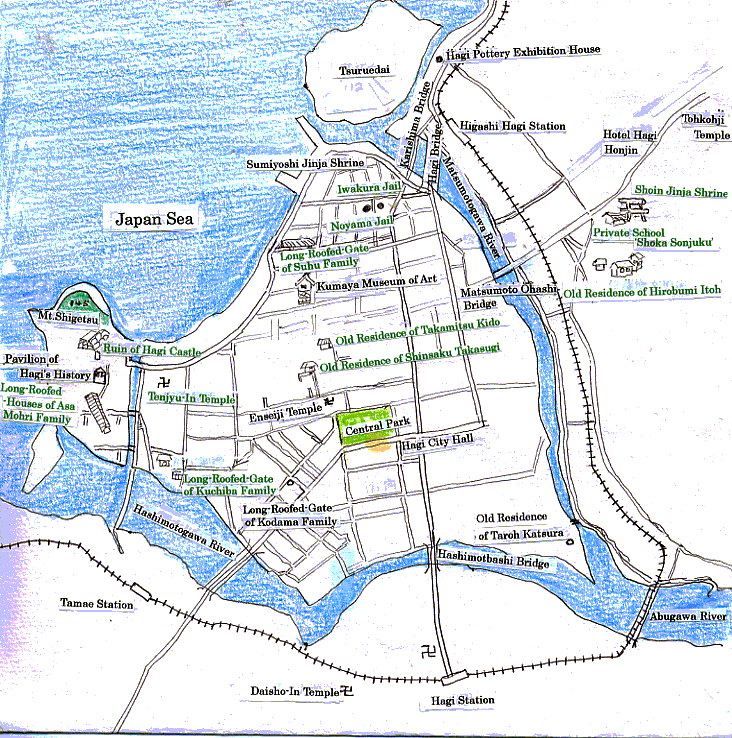 MAP OF HAGI CITY Hagi City leaves the old castle town in the end of Edo Era and the time of Meiji Restoration. |
Several samurais of the highest class who were
called "Jyushin" (high ranked retainers) could live
in the place of the nearest to the castle.
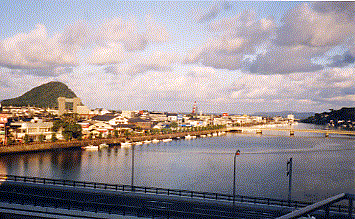 |
Figure1 The photo shows the look of Hagi City. from River-Side Hotel. The mountain is Mt.Shigetsu where Hagi Castle stood until Meiji Restoration. |
TOO POOR APPEARANCE OF
"SHOKA-SONJYUKU" PRIVATE
SCHOOL AND ITOH'S HOUSE
IN BOYHOOD SURPRISES
VISITORS
Samurais of lower class were allowed to live in
the area at the feet of the moutains beyond
Matsumotogawa River, as shown by the map of
Hagi City. In the premises of Shoin-Jinjya Shrine,
there are Shoka Sonjyuku Private School and
Shoin Yoshida Historical Musium.
There is also an old poor straw-thatched house in
which Hirobumi Itoh, one of the most distinguished
persons of Meiji Era and Japan's first prime minister
once had lived during his nine to fourteen years of
age.
The manucipal government also moved and rebuilt
a private house of Japanese and Europian style in
which Hirobumi Itoh built in Shinagawa, Tokyo after
he became a distinguished figure. The house is
open to the public.
Shoin Yoshida's life was so short for only 30
years of age. He was arrested by Edo Shogunate
and was executed to death in the middst of
the great arresting called "Ansei-no-Taigoku"
under the suppression by Tairoh (corresponded
to the present Prime Minister) Naosuke Ii at the
end of Edo Shogunate, who was the highest
retainer of Shogun and at the same time the
lord of Hikone Clan.
Shoin had taught less than twenty samurais of
lower class in Hagi Clan for only one year but
his influence was extremely great that his
students became the real motive power to awake
Japan from the sleep of feudalism of Edo Era and
made her begin to walk towards modern nation.
Takamitsu Kido, Shinsaku Takasugi, Kyuichi Irie,
Minemaro Yoshida, Issei Maebara, Yajiro Shinagawa,
Yasushi Nomura, Akiyoshi Yamada, Shyodo
Matsuura, Hirobumi Itoh, Kaoru Inoue, Aritomo
Yamagata, Kanae Matsumoto. They all took effort
to try to change Japan's helm towards modern
nation at the risk of their lives, by allying with
Satsuma Clan and succeeded in the Meiji
Restoration.
Viorating the national interdict, Shoin planned
secret navigation to Western countries to know
what those advanced countries were and privately
rowed a boat to the flagship of the American
Fleet headed by Commodore Perry in 1857 but
Perry refused to Shoin's solicitation to embark.
His feeling of patriotism and his will of action
were unparalleled.
He later planned an assasination of an "Rohjyu"
(a minister in Edo Shogunate), gave himself up to
the then police, was arrested and executed to
death. He left a Waka ( a poem of 31 phonetic
sounds) as his dying words before the execution,
which made many samurais of lower class be
inspired.
The waka was "Mi wa Tatoe Musashi-no-Nobe
-ni Kuchirutomo Todome Okamashi Yamato-
Damashii" (Even my body decays at Musashino
Field, my spirit as a Japanese will live eternally.)
It is said that the executer was deeply touched
by Shoin's politeness and manliness.
Shoin Yoshida Historical Museum reproduces
his short life by using more than seventy wax
dolls of human size. Shoin Jinjya Shrine was
built in Meiji 23 (1904).
Surprisingly Smallness of Shoka Sonjyuku Private School
All visitors are surprised by too smallness and
too poorness of Shoka Sonjyuku Prvate School
preserved in the shrine.
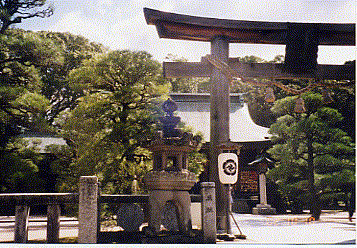 |
Figure2 Shoin Jinjya Shrine was built in Meiji 23 (1904). |
| Figure3 Visitors surprise at the too smallness of Shoka Sonjyuku. Around 20 students studied here triggered Meiji Restoration 140 years ago. |
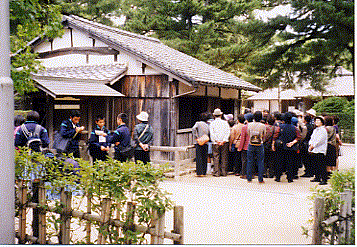 |
At the beginning, Shoin's uncle Bunnoshin Tamaki
established this private school and then
Gorohzaemon succeeded it. And lastly, Shoin
succeeded it in 1857 when he failed his plan
of secret navigation to the advanced western
countries and was prisoned by Hagi Clan in
accordace with Edo Shogunate's order and
further he was moved to be inprisoned his
father's house.
Shoin educated an education of patriotism
to his students witout any discrimination of
whether they were sons of samurais of
upper class or ones of the lowest class. He
gave decisive influence to these youth to make
Japan wake up from feudalism and advance
towards a modern nation in the middst of
circomestances that western countries compete
to invade Asian countries. Moreover the period
Shoin taught them was only one year when he
was confined in his native house released from
inprisonment in Hagi Clan's jail.
At the outset of Shoka Sonjyuku Private School
was a poor wooden tiled roof of only one room
of eight mats, and Shoin himself built later one
more room of ten mats in co-operation with his
students in addition to the previous room.
Hagi City Preserves Two Houses
in Which Itoh Had Lived
Verious historians and writers have wrote books
analizing Hirobumi Itoh's life in Meiji Era or
novels describing him, as he left many letters
adressing to his wife Umeko or his friends, and
memos and records of his lectures. Such the
records were bulky.
And regretfully, much of the records were burnt
away when Kanto Great Earthquake attacked in
1910. The staff of Room of Preservation of Itoh's
Historical Data in Tokyo which was set up by the
Japanese Government were reading and analizing
this information at that time.
Nevertheless, the records he left other than this
were so huge and they offer precious information
to know what was Meiji Era.
Was it true that samurais in general used to
change their own name many times? Yes it was,
because they were confronting an event of life
and death.
Many of the changed name were adopted not to
discontinue one's lineage. Itoh himself had
changed his name fourteen times. He was born
in 1841 as a son of Jyuzo Hayashi who had been
a farmer in poverty in the side of the Pacific
Ocean in Yamaguchi Prefecture. Jyuzo was
always absent to serve Naoemon Itoh of Hagi
Clan, who was a samurai in the lowest class, to
increase income and returned home a few times
a year. Naoemon put confidence in diligent Jyuzo
and entreated him to be adopted. Accepting
Naomon's request, Jyuzo moved whole his family
to Naoemon's. The poor straw-thached house
has been preserved in Yamatocho Town in the
side of the Pacific Ocean by the manicipal
government, together with Information Pavilion
of Itoh and Itoh Memorial Building.
Hirobumi Itoh's Historical Work
Hirobumi Itoh acted Japan's first Prime Minister
after Meiji Three Great Figures (Takamitsu Kido,
Takamori Saigoh, and Toshimitsu Ohkubo) died.
Kido died due to sickness, Saigoh later fell on his
sword in a rebellion against Meiji Government
called Seinan War, and Ohkubo was assacinated
by a bully who had complain to the government.
Itoh acted Prime Minister three times after sat on
the chair of the first, and became an outstanding
figure to the establishment of Meiji New
Administration by studying how Japan's
Constitution should be after he was away studying
in Europe, and was considering the terms of Constitution.
He was also assacinated by a Korean patriot in
1909 at the platform of Harbin Station on his way
to see former Manchuria. He was 68 years of age.
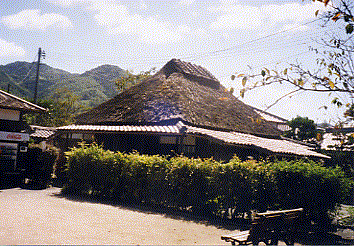 |
Figure4 Hirobumi Itoh followed his father Jyuzo Hayashi and his mother to Hagi, because his father was adopted to become Itoh Family accepting Naoemon Itoh who had acted a 'chugen'( a samurai of the lowest) in Hagi Clan. Hirobumi was only six years old then. Later he acted the first prime minister in Japan. |
| Figure5 Hirobumi Itoh built his own house of Japanese and Western style in Shinagawa, Tokyo, after success of Meiji Restoration. Hagi City Government moved the house to the space neibouring the avobe straw-thatched house and it has been managing it. Both houses are open for the public. |
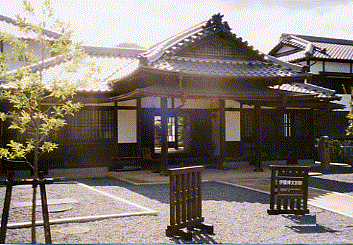 |
Figure 4 shows the straw-thached house of
27 tsubos (only 89 square meters) to which
Hirobumi Itoh and his parent moved
from the house in Yamatocho Town, when
Hirobumi was six years old. You will see
a small room he read books.
Hirobumi Itoh was born in 1841. His father Juzo
Hayashi was a farmer next to the headman of a
village in the present Kumage County, Yamaguchi
Prefecture but as I wrote earlier he was so poor
that he had to work all year long in Hagi in the
opposite coast. Juzo was entreated to be adopted
by Naoemon Itoh who was a samurai of the lowest
Hagi Clan and he moved to Hagi together with his
wife and son. It was when Hirobumi was six years
old.
Hirobumi began to study kanji chalachters and
to read when he was eight years old at a private
school. He was put out to Hohkohin Temple when
he was ten years old and had done studying there
serving to the priests for one and half year.
In 1852 he served as a youngster service man
for Fukuhara, Kodama, and Ihara Families who
had acted the highest ranked samurai of principal
retainer class and then he was called to Mohri
Family as a retainer of the lowest class in
January next year.
In july in the same year Commodore Perry arrived
in Uraga near to Edo, heading American fleet of
four modern worships. The public and Edo
Shogunate were very much surpprised at its arrival,
as a comic poem of 17 phonetic symbols saying;
Jokisen tatta Shihai de Yoru mo Nerarezu (Only four
steamships brought us sleepless for nights.)"
note: in Japanese language phonetic sound 'Jokisen' means 'steamship' and the nearly
same sound 'Shokisen' is the name of a kind of fine green tea.
Edo Shogunate allocated Hagi Clan the mission of guarding Soshu ( the present Kanagawa Prefecture)
including Uraga and Hirobumi (then Risuke) Itoh
was appointed a servant to Accident Exserminer
of the clan Ryozo Kuruhara. Kuruhara was a man
of preeminence with capability of foreseeing new
age. Perceiving Itoh's quality, Kuruhara introduced
him to Shoin Yoshida to study in Yoshida's private
school Shoka Sonjuku.
Itoh was later appointed a servant to Kogoroh
Katsura (Takamitsu Kido one of the three highest
persons (with Saigo and Ohkubo) in early Meiji
Administration, participated in the plan of
"reverence for the Emperor and expulsion of
foreigners" (called "Sonnoh Jyohi" in Japanese,
but changed his mind to "civilization" after away
studying in England with Monta Inouwe (later
Minister of Foreign Affairs in Meiji Administration).
They learned and saw what the advanced nations were.
Knowing the war plan to fire the English Fleet by
Hagi Clan on a newspaper in London, he stoped
his away studying and rapidly returned home
with Inouwe to try to persuade the lord of the
clan not to carry out it. Nevertheless, their effort
failed and Bakan War was open by which Hagi
Clan defeated. Then he lived through Boshin War,
Nisshin (Japanese-Sino) War and Nichiro (Japanese-Russio) War.
On a slope of eastern side of Hagi in which was
the area samurais of lower class lived, there is
Hotel Hagi Honjin having a wide premises. The
temple standing in upper side of the hotel is
Tokohji Temple. It is the family temple of the
lords of Hagi Clan who had an odd numbered generation
and the 500 stone lanterns stand by their graves. By
the way, Daisyo-In Temple being situated in the
place near JR's Hagi Station is the family temple
of the lords who had a even numbered generation.
Hagi Castle Town Leaves Much
of Historical Scene in The End
of Edo Era
Houses of Kido and Takasugi Were Born
The district on the delta zone on Abugawa River is
the former Hagi Castle town where leaves historical
atmosphere of the grand romance of Meiji
Restoration. There are the former dwellings of
Takamitsu Kido and Shinsaku Takasugi near Central
Park (See Map of Hagi). They took the most important
role in the success of Meiji Restoration.
Takamitsu Kido with capability of leading the young
samurais with his intelect in Hagi Clan was born in
1833 as the second son of Masakage Wada, a
physician serving the clan. He was called Kogoroh
in his childhood. And a neighbor Kurobei Katsura
a samurai of the clan entreated Masakage to be his
adopted. After grown up, Kogoroh was told to call
Kido as his second name by the clan.
At the clan's school Rinmeikan ranked one of the
highest level of clan's schools comparable to Kodohkan
of Mito Clan (The clan was one of the three relatives
of Tokugawa Shogun), he was taught military affairs
and tactics by Shoin Yoshida. As to 'kendo'
(Japanese fencing) Kido studied under Yakuroh
Saitoh in Edo, who were open a fencing school of
Shinto Munenryu (a way of Shinto Freedom from all
thoughts) and became Head of the scool after he
mastered it.
Nevertheless, he never killed one with a sword.
He had always escaped from persuing by
Shinsengumi under the control of Edo Shogunate
(the group of masterless samurais) which had
killed with swords many samurais with thought of
loyalism to the Emperor and overthrowing the
shogunate. He was called "Kido of escaping".
He believed "mastering the mysteries of fencing
is to win without battling".
He was ranked to be one of Meiji's Three Greats,
together with Takamori Saigo and Toshimichi
Ohkubo, but regretablly Kido died of illness when
he was 44 years old. He took effort to enact
'abolishing clans and organizing prefecures'.
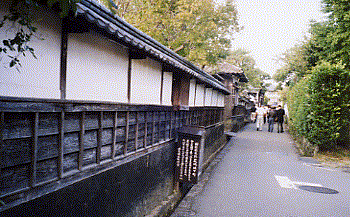 |
Figure6 In the area where Shinsaku Takasugi's old house stood samurais of middle class were living. You can see the long white wooden walls here and there. |
| Figure7 Shinsaku Takasugi or Hirobumi Itho often played in the premises of this Konpira Jinjya Shrine.. |
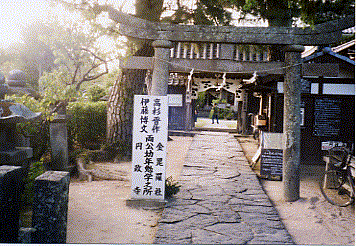 |
Shinsaku Takasugi who was a man of action and of
boldness regretablly died of tuberculosis when he
was only 29 years old. He had outstanding capability
of seeing through the future, of understanding
reality and was full of resources. On top of these,
he was given the licence of the way of Yagiu
Shinkage (a way of Japanese fencing). He moved
like a violent wind when he does something. He
gave great influences on the patriots of lower class
in Hagi Clan.
Had he lived more long, he must have given much
more influences on Meiji Administration.
The explanation board in front of his residence
which Hagi City municipal government tells
Takasugi's life as the following:
| Brief Story of Shinsaku Takasugi's Life His name was called Shumpu and his close name was Nobuo, but the most well known popular name was Shinsaku. He also used changed names as Umenosuke Tani, Senzo Tani, or Tohko, Ikkyosei Saikai and Ikkyosei Tohsei. He was born on August 20, 1839 as the first son of Kochuta Takasugi and Michiko Muro here, Kikuya Yokocho, Hagi. He studied at a private school in his childhood, learned civil and military affairs at Meirinkan in his boyhood and later was taught by Shoin Yoshida at Shoka Sonjuku. In 1861 he was singled out as a page to the Prince of Hagi Land Lord and in 1862 he attended a messenger group of Edo Shogunate to Shnhai, China. At that time he grasped the circumstances of the world (by seeing how Shanhai's situation was) and after returned to Japan, he became a forerunner of expulsionism of foreigners. In 1863 when Hagi Clan attacked foreign ships at Bakan, he organized a troop called 'Kiheitai' and he was appointed its commander by the clan. Kiheitai was the first army force in Japan in which any difference among classes as samurais,farmers, industrial craftsmen and merchants were ignored. Later those who organized an army force continued to appear and these forces formed a strong base of the anti-Edo Shogunate of Hagi Clan in terms of Meiji Restoration War. Then Takasugi temporally deserted from the clan and he had to be imprisoned because of getting a punishment for his action against the Shogunate. But in 1864 when defeated in Bakan War with England, France, Holand and United States, he was allowed by the lord to act the ambassader of the peace conference. He negotiated with great dignity and saved a danger of Japan's land. Because the leaders of Hagi Clan were occupied by those of peace-at-any-price immediately after Kinmon Incident, he fled to Kyushu. As soon as the opportunity arrived, he raised force by commanding "Kiheitai" at Chofu Kohzanji Temple. He fought one place after another like a gust of wing and swept those of peace- at-any-price. He took effort to form alliance with Satsuma Clan before Edo Shogunate organized the Second Subjugating Chosyu (Hagi Clan) in 1866. When the subjugating force arrived, he commanded the whole forces of the clan and he himself attacked Kokuraguchi. He led Hagi Clan to win battle after battle, using his resources crosswisely. He died of illness on April 14, next year in Akamaseki. His body was consigned to the grave at Yoshida Shimizu, Shimonoseki City. Meiji Administration later confered him Sho Degree Four in 1890. About This Residence This old residence was owned by his father Kochuta Takasugi who was given 200 kokus by the clan.The exsiting building includes one 'zashiki' (drawing room of 6 mats with an alcove), one suite (of 6 mats), three living rooms (of 6, 4, 5 mats), entrance, and kitchen. He had also one storehouse and one shed but they do not exsit. There left a small shrine and a well in the garden. Related Historical Places in Hagi City 1.The grave of Nobuo Takasugi (with the hair of the departed) 2.Old site of Meirinkan School at Emuki 3.Shoka Sonjuku School at Matsumoto in Tsubaki Higashi-ku 4.Ruin of Hagi Castle |
Long-Roofed-Gates Show
The Living of Samurais of
The Highest Class
There left here and there the long-roofed-Gates
('nagaya-mon' in Japanese) showing the living of
samurais of the higest class who acted principal
retainer or quasi-principal retainer.
You can see the long roofed-gates of the
residences
of Masanosuke Sufu who helped the group of young
samurais asserting reverence for the Emperor and
opening Japan to foreign intercourse which headed
by Takasugi, of Kuchiba Family who acted quasi-
principal retainer, of Kodama Family ranked to the
same level as Kikuchi Family, and of Seifu Murata
who made a reformation the management of Hagi
Clan.
There is an old long roofed-houses ('nagaya' in
Japanese) used by the retainers of Asa Mohri
Family in the district of Hagi Castle forming
like island. The building has been preserved as
a national cultural property. Please pay the
entrance fare. And the flier explains this building
as;
"The founder of Asa Mohri Family" was Motoyasu,
the eighth son of the founder of Mohri Family. The
branch family had been given more than 8,371 kokus
and the main given land was situated in Asa (the
present Asa County, Yamaguchi Prefecture). The
branch family, however, had their residence here in
which they had lived.
It stood in the important position 100 meters aparted
for south from Ohtemon Gate of Hagi Casstle in the
land of 15,500 square meters. The main building and
the garden were scrapped around Meiji Restoration
except the exsiting long roofed-haouses."
The length of the long roofed-houses is 51.5 meters
and is a typical long roofed-houses building including
some rooms of samurais called 'chugen' (name of
one of the lowest class together with 'ashigaru').
Cultural Properties Left by
Kumaya Family,The Wealthy Marchant of Hagi Clan
Kumaya Museum of Art is situated in the space
near to Sufu Family's long roofed-gate 'nagayamon'.
In 1754 Shigenari Mohri, the seventh lord selected
Goemon Yoshimitsu Kumaya, a merchant of ones
who lived in Hagi Castle Town and decided to be
the merchant under Hagi Clan patronage as a part
of rebuilding its financial administration.
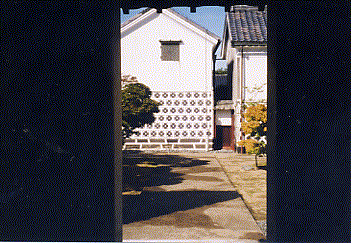 |
Figure8 Kumaya Family was selected to be dedicated merchant to serve Hagi Clan among ones who were living Hagi Castle Town and had collected many precious arts and important precious properties. For example, you@can see the oldest piano presented by Siebolt... |
Since Yoshimitsu Goemon built the main building
and many houses with store buildings in his wide
site, Kumaya Family have lived until today here
for 230 years. The present head is Mr.Goemon
Kohzo, the tenth head. The buildings are registered
as the national important cultural properties. Of
these buildings, the white store houses are open
for the public as Kumaya Museum of Art. You can
see many precious cultural properties here such as
the oldest piano in Japan which Siebolt sent to
Yoshikazu, the fourth head. He was an intimate
friend for Siebolt.
October 16, 2004
GO TO PAGE SHOWING CONTENTS
GO TO MIDDLE IZU PROVINCE
GO TO MISHIMA CITY
GO TO SHUZENJI TOWN
GO TO NIRAYAMA TOWN
GO TO KAWAGOE CITY
PLEASE WRITE YOUR COMMENT

